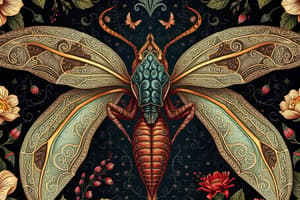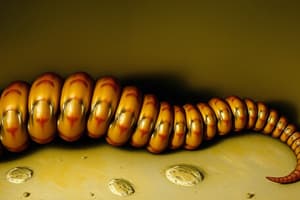Podcast
Questions and Answers
What is the primary function of the proglottids in Cestoda?
What is the primary function of the proglottids in Cestoda?
- To produce and release ova. (correct)
- To aid in locomotion.
- To store nutrients.
- To facilitate excretion.
Which characteristic helps in differentiating species of Cestoda?
Which characteristic helps in differentiating species of Cestoda?
- Shape and internal structure of the proglottids. (correct)
- Length of the scolex.
- Size of the hooks.
- Color of the strobila.
What distinguishes Eucestodes from Pseudocestodes in terms of ova release?
What distinguishes Eucestodes from Pseudocestodes in terms of ova release?
- Eucestodes have lateral branches distended with ova, unlike Pseudocestodes.
- Eucestodes liberate eggs through the strobila, in contrast to Pseudocestodes.
- Eucestodes shed segments intact, whereas Pseudocestodes have a uterine pore. (correct)
- Eucestodes release ova through the genital pore, while Pseudocestodes do not.
How many cephalic ganglia are associated with the nervous system of Cestoda?
How many cephalic ganglia are associated with the nervous system of Cestoda?
In terms of morphology, which of the following statements is true regarding the neck of Cestoda?
In terms of morphology, which of the following statements is true regarding the neck of Cestoda?
What is the primary method of egg dissemination for Eucestoda (Cyclophyllidea)?
What is the primary method of egg dissemination for Eucestoda (Cyclophyllidea)?
Which characteristic is NOT associated with the genus Diphyllobothrium?
Which characteristic is NOT associated with the genus Diphyllobothrium?
Which of the following larval stages is categorized as a solid type?
Which of the following larval stages is categorized as a solid type?
In which stage do Eucestoda embryos develop before hatching?
In which stage do Eucestoda embryos develop before hatching?
What is the function of the bothria found in Cotyloda (Pseudophyllidea)?
What is the function of the bothria found in Cotyloda (Pseudophyllidea)?
Flashcards
Cestoda (Tape worms)
Cestoda (Tape worms)
A class of parasitic flatworms characterized by a segmented body (strobila) and a head (scolex) with hooks or suckers for attachment.
Proglottids
Proglottids
The individual segments that make up the body of a tapeworm. They are continually budded from the neck region and progress through immature, mature, and gravid stages.
Scolex
Scolex
The head of a tapeworm, equipped with hooks or suckers for attachment to the host's intestine.
Excretory System in Tapeworms
Excretory System in Tapeworms
Signup and view all the flashcards
Tapeworm Reproduction
Tapeworm Reproduction
Signup and view all the flashcards
Cestode Classification
Cestode Classification
Signup and view all the flashcards
Pseudophyllidea (Cotyloda)
Pseudophyllidea (Cotyloda)
Signup and view all the flashcards
Eucestoda (Cyclophyllidea)
Eucestoda (Cyclophyllidea)
Signup and view all the flashcards
Diphyllobothrium (Cestode)
Diphyllobothrium (Cestode)
Signup and view all the flashcards
Spirometra (Cestode)
Spirometra (Cestode)
Signup and view all the flashcards
Study Notes
Veterinary Parasitology: Helminthology and Immune Parasitology
- Course code: PAR314
- Lecturer: Dr. Mohamed Abdelmoghny
Phylum: Platyhelminthes, Class: Cestoda (Tapeworms)
- General characteristics: Elongated, ribbon-like worms, flattened dorsoventrally, no body cavity or alimentary canal
- Parasite type: Endoparasites, found in small intestine of vertebrates (except Anoplocephala in large intestine of equines). Stilesia hepatica and Thysanosoma actinoides are found in bile ducts of sheep and cattle.
- Body segmentation: Segmented (proglottids), size varies from few millimeters to several meters
- Reproductive system: Hermaphroditic, each mature segment contains one or two sets of male and female reproductive organs
- Life cycle: Mostly indirect, larval worms (metacestodes) inhabit tissues of vertebrates and invertebrates intermediate hosts
- Order Eucestoda (Cyclophyllidea): True tapeworms, scolex with four suckers, non-operculated egg
- Order Cotyloda (Pseudophyllidea): Pseudo-tapeworms, scolex with two longitudinal slits, operculated egg
General Morphology: External Structure
- Size: 3 mm (Davainea proglottina) to over 20 meters (Taenia spp.)
- Color: White creamy or yellowish
- Body: Head (scolex) with attachment organs, short unsegmented neck and a chain of segments (strobila), each segment is a proglottid. Number of proglottids varies (3 for Echinococcus to 4000 for Taenia spp.)
- Scolex: Globular or pyriform structure for attachment to the intestinal wall, via suckers (Taenia saginata) or rostellum with hooks (Taenia solium), or bothria (Diphyllobothrium latum).
- Pseudoscolex: Anterior part of the strobila in early developmental stages of cestodes providing a holdfast organ
General Morphology: Internal Structure
- Excretory system: Flame cells leading to efferent canals, uniting at the posterior part of each segment, running through the strobila.
- Nervous system: Two cephalic ganglia in scolex, connected by a nerve ring, with six longitudinal nerve cords (two dorsal, two ventral) running posteriorly.
- Reproductive system: Hermaphroditic, each mature proglottid contains a set of male and female reproductive organs. In Eucestoda, genital pores usually open on the lateral margins of segments (unilateral or irregular alternates). In Pseudocestoda, male and female genital pores have a common opening on the ventral surface.
General Life Cycle and Developmental Stages of Cestodes
- Life Cycle: Indirect. One or two intermediate hosts are required for Eucestodes and Pseudocestodes
- Eggs: In Eucestodes, eggs are detached in chains and are non-operculated, containing a mature hexacanth embryo (onchosphere). In Pseudocestodes, eggs are shed through the uterine pore from the ventral surface,operculated
- Metacestodes (larval stages of cestodes): Include Cysticercoid, Cysticercus, Coenurus, and Strobilocercus
Metacestodes (larval stages of cestodes)
- Cysticercoid: Small solid cyst with a single evaginated scolex, for non-taeniid eucestodes like Moneizia and Dipylidium.
- Cysticercus: Large fluid-filled bladder-like cyst with a single invaginated scolex (Protoscolex), found in the tissues of vertebrate intermediate hosts (Taeniid worms)
- Coenurus: Larger than cysticercus, numerous invaginated scolices, delicate membranes, found in the CNS or subcutaneous tissues of the vertebrate intermediate host
- Strobilocercus: Worm-like cyst with a single evaginated scolex, containing segmented strobila, without sexual proglottids (larval stage of T. taeniaeformis developed in rodents)
In Eucestodes (cystic larvae)
- Hydatid cyst: Large fluid-filled cyst with germinal epithelium, containing invaginated scolices (brood capsules). Produced endogenously or exogenously
- Procercoid: Elongated body with a cephalic invagination and a posterior spherical appendage (Cercomer) with embryonal hooklets. This develops from Coracidium in the first intermediate host (Cyclop).
- Plerocercoid: 1.5-2 cm in length. Formed in muscles or liver of the second intermediate host( fish).
Difference between the two orders of Cestodes
- Character | Cotyloda (Pseudophyllidea) | Eucestoda (Cyclophyllidea)
- Scolex | Almond or spoon-shaped with slit-like grooves (bothria) | Globular with 4 Suckers and rostellum (with or without hooks)
- Strobila | Genital pore on ventral surface, uterine pore, no gravid segments.| Genital pore on lateral surface, uterine pore, gravid segments present
- Egg Dissemination | Ova only (operculated, unembryonated) | Ova are operculated and embryonated,with proglottids
- Diagnostic stage | Coracidium or ciliated larva (free swimming) | Oncosphere, hexacanth embryo
- Intermediate Host | Occurs in water; two intermediate hosts (Cyclops & fish) | One intermediate host
- Larval stage | Solid | Bladder or cystic
Classification of Cestodes
- Order Pseudophyllidea (Cotyloda)
- Family Diphyllobothriidae: Genus Diphyllobothrium (D. latum) and Genus Spirometra (S. mansoni)
- Order Cyclophyllidea (Eucestoda)
- Family Taeniidae: Genus Taenia -T. saginata, T. solium, T. hydatigena, T. ovis, T. pisiformis, et al.
- Note additional classifications (families, genera) are given throughout the document
Human Sparganosis
- Definition: Infestation of human tissues by the larval stages of Diphyllobothrium (= Spirometra) mansoni, which are called Sparganum. (up to 10–20 cm long)
- Methods of Infection: Eating insufficiently cooked fish, pigs, frogs, and reptiles with plerocercoid stage (Sparganum)
- Pathogenesis and clinical signs: Irregular nodules. Can affect various tissues, particularly the periorbital area, can lead to inflammation, edema, and pain
Epidemiology, Diagnosis, and Control of Taenia and Diphyllobothrium Species
- Epidemiology: factors impacting spread: sanitation, human behavior, fish-eating habits, and animal husbandry
- Diagnosis: Clinical symptoms (non-specific), egg examination of feces, observation in stool
- Control: prevention involving sanitation, proper food handling, and meat preparation techniques
Studying That Suits You
Use AI to generate personalized quizzes and flashcards to suit your learning preferences.




